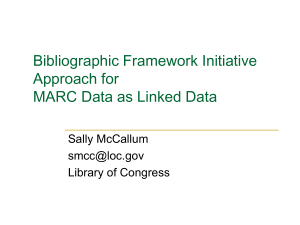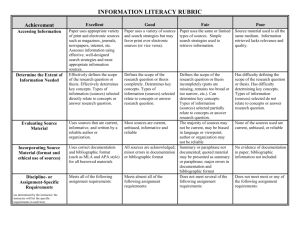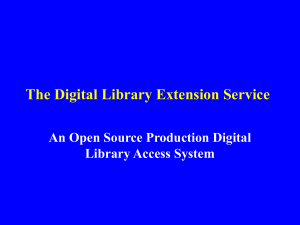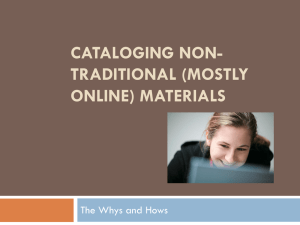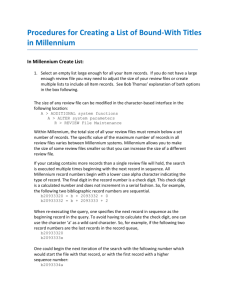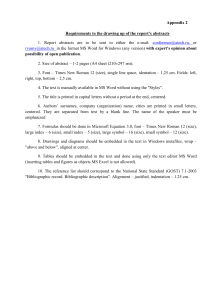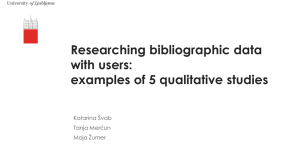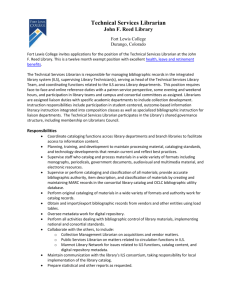Cleaning up the Catalog - Maine Balsam Libraries
advertisement
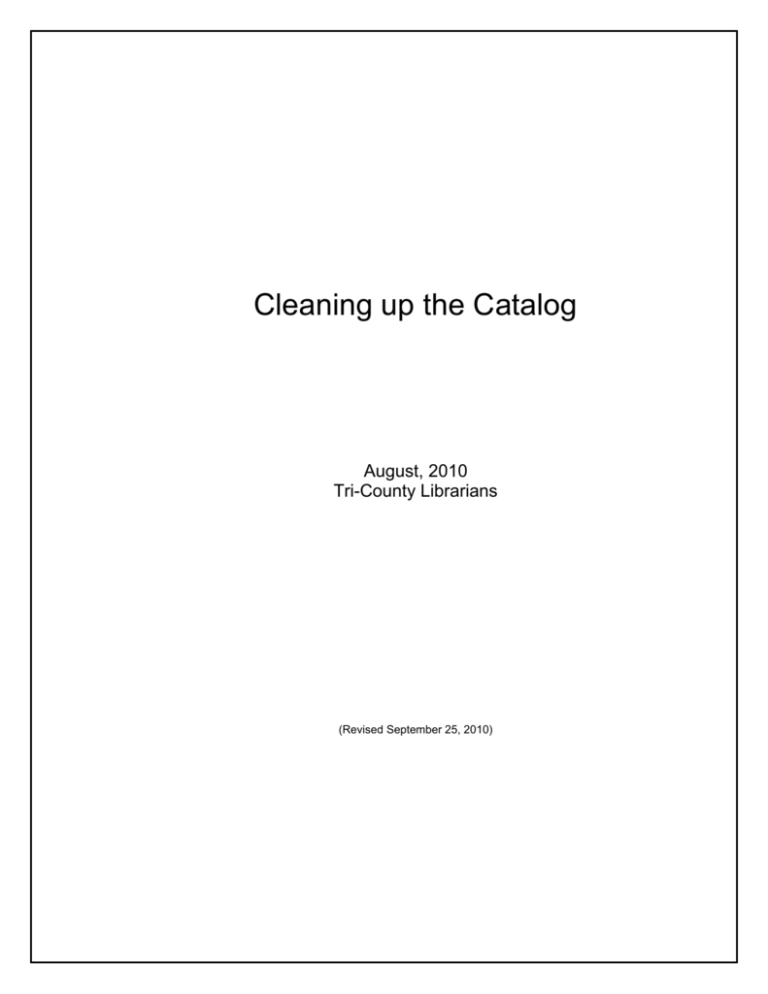
Cleaning up the Catalog August, 2010 Tri-County Librarians (Revised September 25, 2010) Table of Contents Contents 1. 2. 3. Introduction ................................................................................................................................ 3 Good Bibliographic Records ....................................................................................................... 3 Problems – and their solutions ................................................................................................... 4 1. Bad Bibliographic Records – Overlaying Records ................................................................... 4 2. Two Bibliographic Records – Merging Records....................................................................... 5 3. Transferring a Holding to another volume ............................................................................... 7 Page 2 (Revised September 25, 2010) Balsam Libraries Cataloging Training 1. Introduction Bringing scores of thousands of records together into a single consolidated library catalog exposes several problems. First, many of the legacy records are incomplete or even incorrect. Second, each library in the past had their own methods and conventions for cataloging. This results in an uneven collection of records in the consortium. In addition, during the conversion and consolidation process many holdings records were either improperly aggregated under a single bibliographic record, or conversely, failed to be aggregated properly – thus resulting in multiple Bibliographic records for the same type of item. In this document we provide some mechanisms for understanding and correcting these issues. 2. Good Bibliographic Records There are two types of records in Evergreen. The “Bibliographic Record” has all of the generic information about the item, including Title, Author, publication information, physical description, subjects, etc. This information is arranged and presented in Evergreen in “MARC” record format. It is that which is shared by all of the member libraries. The “Holdings Record” contains information unique to each library. It includes such information as the call number, a unique bar code, item price, physical location of the item, etc. In general, in Evergreen there should be only one Bibliographic record for each type of item. Attached to it are all of the holdings records for the libraries having one or more copies of the item . Each library “owns” and controls all of their own Holdings records. The Consortium as a whole owns and controls the Bibliographic records. A good (but not complete), unique Bibliographic record consists of these four pieces of information: 1. Type of item (“Type”, position 06 in the Leader of the MARC Record. Types include “a” – language material, i.e. books; “i’ – non-musical sound recordings, i.e. talking books; “j” – Musical Sound Recordings; and “g” – Projected Medium, e.g. DVD or VCR Recordings) 2. Title (Field 245a in the MARC Record) 3. Author (Field 100 in the MARC Record) 4. Physical description (Field 300 in the MARC Record: 300a is the number of pages; 300c is the physical size) Note that, for cataloging purposes, these match points do not include the ISBN number. The issue here is that often there are very minor differences in publication in the same work (e.g. second and subsequent editions, book club editions, etc.). Each of these usually gets a unique ISBN number. This may result in many bibliographic records for essentially the same type of item. The Consortium recognizes the trade-off between “perfect” bibliographic records where everything, including the ISBN number, matches and ease of use for the patron where there is a more limited set of bibliographic records. They have adopted the convention of leaning more towards ease of use – thus aggregating more holdings into fewer bibliographic records. As long as the above four pieces of information match, libraries can and should put their holdings under the appropriate bibliographic record. Page 3 (Revised September 25, 2010) Balsam Libraries Cataloging Training 3. Problems – and their solutions When cleaning up the catalog you are likely to encounter three types of problems. The first problem is bad bibliographic records. For minor issues, you may edit the record. For really bad records, you should OVERLAY the record. The second problem is that there are multiple bibliographic records for the same type of item. You cure this by MERGING bibliographic records. The third problem is that your particular holdings record is attached to the wrong bibliographic record. You cure this by TRANSFERRING an item to another bibliographic record. 1. Bad Bibliographic Records – Overlaying Records Here the record is simply wrong or egregiously incomplete. You often encounter this with older records, perhaps created with simpler computer systems which did not capture as much information. In this case, you should overlay the bad record with a good record. (From Sitka Training Manual) There are times when it is necessary to overlay an existing MARC record in Evergreen with a better MARC record from a Z39 target. Overlaying a MARC record replaces an existing MARC record and leaves all holdings, and corresponding holds, active circulations, bills, and fines intact. As overlay affects all libraries sharing a MARC record it is critical that this procedure be done judiciously and correctly. You must first identify the MARC record in Evergreen as the one to be overlaid. You do this by “marking” it for overlay. The mark for overlay is by login, and only one record at a time can be marked for overlay. When you mark another record that becomes the marked record. Once the record is marked it stays marked until overlaid, or until you log out of Evergreen. Therefore it is necessary that you mark and overlay one record at a time, following the entire process through to completion before moving on to another record. 1. Select Cataloguing → Search the Catalog, Search → Search the Catalogue or press F3 to search Evergreen for the record that needs to be overlaid. It is best practice to start with a fresh search screen so that all prior searches are cancelled. This ensures the correct title record is opened and marked. 2. Click on title link to display record in Record Summary View. It is important that you ensure the record is fully loaded on screen and displaying title information for the correct record. 3. Select Actions for this Record → Mark for Overlay. Record is now “marked”. Once the record is marked as described above, you can now proceed to the next step, searching for and importing the new record from a Z39 target. Page 4 (Revised September 25, 2010) Balsam Libraries Cataloging Training 1. Select Cataloguing → Import Record from Z39.50 2. Choose targets and enter search terms. 3. Click MARC Editor for Overlay. Note that TCN of Evergreen record marked for overlay is displayed 4. Record is displayed in MARC Edit view. You may edit record from this view if required. Click Overlay Record at top right of screen. 5. Existing record is displayed and you are prompted to confirm overlay. You can move panes around record to view in entirety if required. Click Overlay. 6. Click through confirmation messages. Record in Evergreen is overlaid with new MARC record, with all pre-existing holdings intact. 2. Two Bibliographic Records – Merging Records (From the SITKA Training Manual) Any volume and copy records or holds associated with the brief record will be transferred to the full record upon merging. 1. Create a bucket for the records you wish to merge (see the section called “Creating Record Buckets” for detailed instructions). In the examples below the bucket is named Horse Books. 2. Identify records to be merged and add them to the bucket (see the section called “Adding Records to Buckets”. Page 5 (Revised September 25, 2010) Balsam Libraries Cataloging Training 3. Retrieve the bucket by selecting Edit → Record Buckets or Cataloguing → Manage Record Buckets. 4. Select all the records in the bucket by pressing Shift+Click to highlight them all, then click Merge All Records. 5. Select one record as the Lead Record, which would be the better quality full record, and click Merge. In this example record # 30545815 is the Lead Record. The brief record has been subsumed by the full record, and all of the volumes, copies and holds associated with the brief record are now attached to the full record. Page 6 (Revised September 25, 2010) Balsam Libraries Cataloging Training 3. Transferring a Holding to another volume The third problem you are likely to encounter involves your having a holdings record attached to the wrong bibliographic record. To move an item, you first mark the volume to which you wish to attach your holding: Locate the bibliographic record to which you wish to move your item. (If the record is not already in Evergreen, use Z39.50 to create the Bibliographic Record (you do NOT need to create an item). Then, in Holdings Maintenance, select the volume line (not an item line) and right-click. Then select “Mark Volume as Item Transfer Destination” Next, locate the item that you wish to move. In Holdings Maintenance, select the item or items (not the Volume line above the item(s)) that you wish to transfer. Then right-click and select “Transfer Items to Previously Marked Volume” A confirmation dialog box appears. Select “Transfer” to complete the transfer. Page 7 (Revised September 25, 2010) Balsam Libraries Cataloging Training

